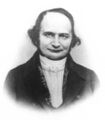Template:Selected anniversaries/February 18: Difference between revisions
No edit summary |
No edit summary |
||
| Line 24: | Line 24: | ||
||1880 – Nikolay Zinin, Russian organic chemist (b. 1812) | ||1880 – Nikolay Zinin, Russian organic chemist (b. 1812) | ||
File: | File:Karl Weierstrass.jpg|link=Karl Weierstrass (nonfiction)|1881: Mathematician and crime-fighter [[Karl Weierstrass (nonfiction)|Karl Weierstrass]] publishes new theory of mathematical analysis with applications in the detection and prevention of crimes against mathematical constants. | ||
||Marius Sophus Lie (d. 18 February 1899) was a Norwegian mathematician. He largely created the theory of continuous symmetry and applied it to the study of geometry and differential equations. | |||
||Eugenio Beltrami (d. 18 February 1900) was an Italian mathematician notable for his work concerning differential geometry and mathematical physics. His work was noted especially for clarity of exposition. | ||Eugenio Beltrami (d. 18 February 1900) was an Italian mathematician notable for his work concerning differential geometry and mathematical physics. His work was noted especially for clarity of exposition. | ||
Revision as of 09:12, 18 November 2017
1809: Physicist and academic Antoine César Becquerel uses electricity to power new type of scrying engine.
1851: Mathematician and academic Carl Gustav Jacob Jacobi dies. He made fundamental contributions to elliptic functions, dynamics, differential equations, and number theory.
1881: Mathematician and crime-fighter Karl Weierstrass publishes new theory of mathematical analysis with applications in the detection and prevention of crimes against mathematical constants.
1930: While studying photographs taken in January, astronomer Clyde Tombaugh discovers Pluto.
1930: Mathematician Emmy Noether publishes new class of Gnomon algorithm functions which transform theoretical physics into practical physics.
1967: American physicist and academic J. Robert Oppenheimer dies. His achievements in physics included the Born–Oppenheimer approximation for molecular wavefunctions, work on the theory of electrons and positrons, the Oppenheimer–Phillips process in nuclear fusion, and the first prediction of quantum tunneling.





